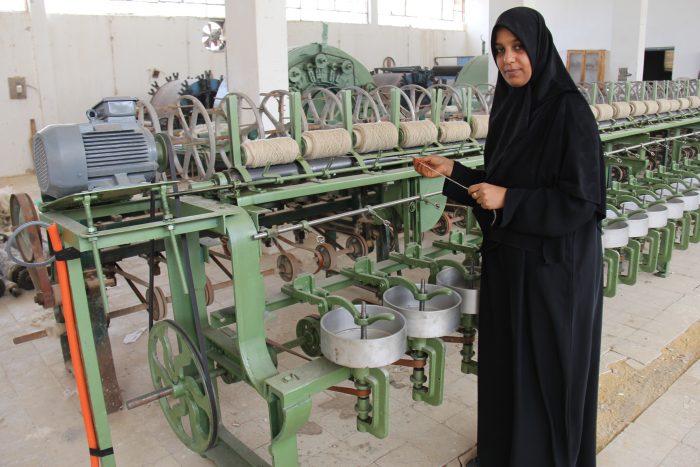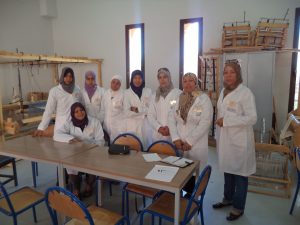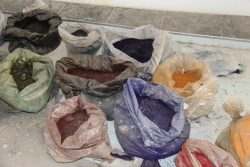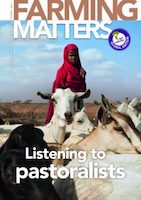A training unit for spinning and manufacturing woolen handicrafts in the Alqasir village, Egypt, has become a place where women not only gain skills from which they can earn an income, but also a place to connect with their cultural heritage. This is a story of one of the first trainees, who quickly became a trainer and shares her passion for the preservation of Bedouin heritage.

The Matrouh governorate stretches west of Alexandria to the Libyan border, and all the way south to the Siwah Oasis. Matrouh is a coastal desert governorate which is known for its traditional tribal character. In Matrouh, the Bedouin traditions of generosity, chivalry, noble ethics, cooperation, and respect for our heritage are passed from one generation to the next. But the same traditions restrict the work of women outside the household.
In 2004, the Desert Research Center of the Egyptian Ministry of Agriculture and Land Reclamation, set up a wool spinning and manufacturing unit, the first of its kind in Matrouh. The General Council of the governorate, which maintains the unit building, funded the purchase of equipment for drying and sterilising, carding and spinning the wool, as well as a quilting machine. I joined one of the first training courses, and as a trainee the idea of preserving our Bedouin heritage occupied my thoughts. I saw that we had to teach young girls how to earn an income with traditional weaving methods, and this became my mission.
Training a new generation

Three years later, in 2007, with the help of a number of other women at the wool spinning and manufacturing unit, we started an initiative to teach women and girls how to produce handicrafts using traditional weaving techniques. We taught them more than just the act of weaving: the threads and colours we use are related to the environment and to the general context we live in. It is as if we are putting our feelings and senses into each piece of work. The traditional designs used are alhawaya, alareej, alshabor and alnawayri.
My mother taught me how to use the masad for weaving. But to teach others I needed first to find women who could work outdoors and help me teach young girls about our traditional designs. This was not easy, but I was lucky to find Zainab, from whom I learnt a lot about tools and techniques. I also found two young women who were very interested in our local heritage and who, at the same time, had a lot of experience producing handicrafts. We have been working together since then, exchanging ideas, acquiring new skills, and improving what we do.
Among the many activities we engaged in, the most influential was the training of 90 girls inside the spinning and manufacturing unit. Many of them came from the Wadi Alramel village, and were trained by women from the same village. Afterwards, we also made an effort to work with disabled girls, including those who are blind. During the training sessions we encourage the Bedouin girls to follow in the footsteps of their ancestors and use traditional designs. We try to use local materials and inputs, such as yarn from sheep wool of different colours.
The need to preserve our local heritage through traditional handicrafts is not widely recognised, but it is important in many ways. Our traditional heritage is closely related to what Bedouin women do. It is also strongly linked to the pastoral communities of the Matrouh governorate, where many different economic, environmental, social and educational factors are involved. Moreover, handicrafts are an important source of income for women and their families.

Families in this desert area depend primarily on their animals, and using the wool that is otherwise discarded provides them with an alternative source of income. The use of easily available raw materials (making natural dyes, for example, from onion leaves or curcuma), means that no additional costs are involved. Above all, this work provides income opportunities to the Bedouin women as it is work they can do at home. Due to the local traditions, women can find it very difficult to work outside of their homes or to travel to other villages. One of the reasons why our work has been such a success is because we take these limitations into account when planning where to do trainings, making it much easier for women to participate.
We taught them more than just the act of weaving
Not an easy road
But I also faced many difficulties when I started working. It was not easy to convince the Bedouin families or the local authorities of the importance of what we were doing. Many of them openly questioned the benefits, wondering if it was worth investing any time or money. In addition, it was difficult to go to places like Alqura and Nuju’. Women cannot freely leave their houses, so it was necessary to meet women in their homes. I also had to get the approval of my parents to travel abroad, and working outside, and travelling long distances between pastoral clusters was challenging.
I had expected that many men would not support the training initiative, as their wives and daughters would become more independent as they would earn their own income. This is why I decided to talk to them first, and to present what we were planning to do. We were able to convince families to let their daughters and wives participate, by highlighting the financial and educational possibilities this could bring, in addition to the cultural benefits. Given the general difficulties women face in working outside the home, it was important to find partners who would support the cause. The participation of Sheikhs and village elders was positive, as they welcomed the idea. They understood that this move would reflect positively on all Bedouin women. The Matrouh radio station also helped us reach all families directly and promoted the trainings, explaining what we wanted to achieve, and encouraged listeners to join us.
My personal journey
My work in the spinning and manufacturing unit helped me discover something I really wanted to do and develop further. In only two months, with the encouragement of all those involved, I was promoted and became a team supervisor, and went from being a trainee to a trainer for other girls and women. These changes took place rather quickly because I had a dream and I really wanted it to come true.
During the past four years I have gained a lot of experience and I have become more known in the field. In 2011 joined a meeting organised by the World Alliance of Mobile Indigenous People, WAMIP, in India. I participated alongside 50 other pastoralists from many other countries. Later, I also joined other global pastoral gatherings, in Kenya in 2013 and in Morocco in 2015. I am also a member of the Arabian Pastoralist Communities Network. I have come to know many institutions that work in the field of pastoralism and handicrafts, most of which are interested in building women’s capacities.
My work in the spinning and manufacturing unit helped me uncover and pursue my dream. Along the way, I found many supporters, but also came up against people who did not see the benefits of my work. Nevertheless, I am convinced of the benefits of keeping our ancestors’ traditions alive, and of involving women in the process. These ideas reflect what we do and who we are: our heritage is alive in our traditions, customs and crafts, and also in the food we eat every day. It is true that the general context is difficult, and that living in the desert is challenging. But we can learn a lot from our heritage and culture.
Eaetemad Rafallah Abdallah (eatemad2011@gmail.com) works at the Center of Sustainable Development as manager of the wool spinning and manufacturing unit.

